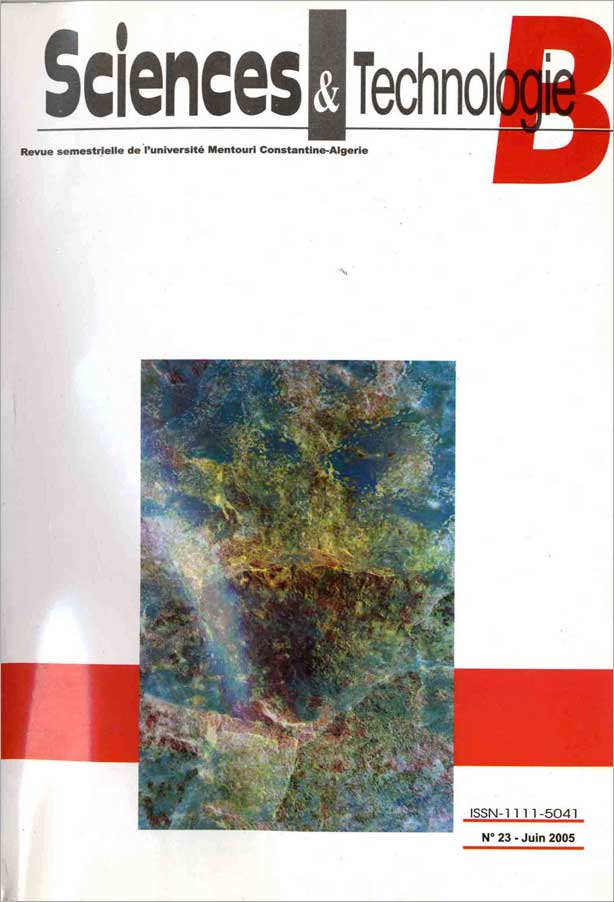IMPEDANCE REPRESENTATION OF TWO PHASE COMPOSITE MATERIALS AND EXPERIMENTAL MODELLING
Mots-clés :
Non destructive method, Impédance, Matrix, Inclusion, Permittivity, Resistivity, Mixture laws, Méthode non destructive, Matrice, Permittivité, Résistivité, Lois de mélangeRésumé
This paper presents a nondestructive method enabling to characterize heterostructures or composite materials based on the equivalent electrical impedance. The heterostructures consist of a host dielectric material (a three-dimensional homogeneous matrix) and dielectric or conducting inclusions. We especially consider two examples of heterostructures used in building namely hollow materials and materials containing metallic tubes simulating for instance hollow bricks and pillars (or pylons) respectively. The mixture laws (i.e., the effective permittivity and resistivity) are also deduced in function of the concentration of inclusions and both the permittivity and resistivity of each component of the heterostructure. To illustrate this method, experimental validation is achieved on samples containing identical aligned inclusions, in the form of square section tubes, embedded in a polymer matrix and which are filled either by air or water. The results predicted by the proposed method are found in reasonable accordance with those obtained experimentally over a wide range of volume fraction of inclusions.
Références
-B. Pincent, D. Méline and J. Auriol, Measurement of the
moisture content variation in non satured, compacted clays,
Geoconfine 93, Arnould, Barrès and Côme (eds), 1993.
-J.P. Baron, La mesure de lateneur en eau par les méthodes
nucléaires, Journées de Physique. L.C.P.C., 1987, pp.151-156.
-P.J. Tumidajski, A.S. Schumacher, S. Perron, P. Gu and J.J.
Beaudoin, On the relationship between porosity and electrical
resistivity in cementitious systems, Cement and Concrete
Research, Vol. 26, No. 4, 1996, pp. 539-544.
-P.J. Tumidajski, Electrical conductivity of Portland cement
mortars, Cement and Concrete Research, Vol. 26, No. 4, 1996,
pp. 529-534.
-Zhongzi Xu, Ping Gu, Ping Xie and J.J. Beaudoin,
Application of A.C. impedance techniques in studies of porous
cementituous materials, Cement and Concrete Research, Vol.
, 1993, pp. 1007-1015.
-Davis J.L., Chudobiak W.J., In situ method for measuring
relative permittivity of soils, Geological Survey of Canada,
Ottawa, 1975, paper 75-1, A, pp.75-79.
-G.C. Topp, J.L. Davis, A.P. Annan, Electromagnetic
determination of soil water content using T.D.R. Evaluation of
installation and configuration ofparallel transmission lines,
Soil Science Society of America. Journal, Vol. 46, 1982.
-G.C. Topp, J.L. Davis, Measurement of soil water content
using T.D.R. : a field evaluation, Soil Science Society of
America. Journal, Vol. 49, 1985.
-O. Buyukozturk, H.C. Rhim, Radar Imaging of concrete
specimens for nondestructive testing, Construction and
Building Materials, Vol. 11, N° 3, 1997, pp. 195-198.
- H.C. Rhim, O. Buyukozturk, Electromagnetic properties of
concrete at microwave frequency range, ACI Materials
Journal, Vol. 95, N° 3, 1998, pp. 262-271.
-Syam K. Mantrala, C. Vipulanandan, Nondestructive
evaluation of polyester polymer concrete, ACI Materials
Journal, 1995, pp. 660-668.
-B. Saréni, L. Krähenbühl, A. Beroual, and C.
Brosseau,"Effective dielectric constant of periodic composite
materials", J.Appl.Phys., vol.80, pp.1688-1696, 1996; ibidem,
"Complex effective permittivity of a lossy composite
material", vol.80, pp. 4560-4565,1996, and ibidem, "Effective
dielectric constant of random composite materials", vol.81,
, pp. 2375-2383.
- A. Beroual and C. Brosseau, Comparison of dielectric
properties determined from a computational approach and
experiment for anisotropic and periodic heterostructures,
IEEE Trans. Dielectrics and Electrical Insulation, vol. 8,
, pp. 921-929.
Téléchargements
Publié
Numéro
Rubrique
Licence
Les auteurs publiant dans cette revue acceptent les termes suivants :- Les auteurs détiennent le droit d'auteurs et accordent à la revue
le droit de première publication, avec l’ouvrage disponible simultanément [SPÉCIFIER LA PÉRIODE DE TEMPS] après publication, sous la licence Licence d’attribution Creative Commons qui permet à d'autres de partager l'ouvrage en en reconnaissant la paternité et la publication initiale dans cette revue. - Les auteurs peuvent conclure des ententes contractuelles additionnelles et séparées pour la diffusion non exclusive de la version imprimée de l'ouvrage par la revue (par ex., le dépôt institutionnel ou la publication dans un livre), accompagné d'une mention reconnaissant sa publication initiale dans cette revue.
- Les auteurs ont le droit et sont encouragés à publier leur ouvrage en ligne (par ex., dans un dépôt institutionnel ou sur le site Web d'une institution) avant et pendant le processus de soumission, car cela peut mener à des échanges fructueux ainsi qu'à un nombre plus important, plus rapidement, de références à l’ouvrage publié (Consulter The Effect of Open Access).

